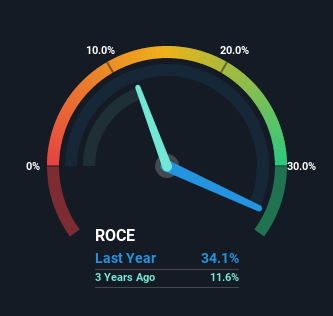- United States
- /
- Oil and Gas
- /
- NasdaqGM:EPSN
Returns on Capital Paint A Bright Future For Epsilon Energy (NASDAQ:EPSN)
Finding a business that has the potential to grow substantially is not easy, but it is possible if we look at a few key financial metrics. Ideally, a business will show two trends; firstly a growing return on capital employed (ROCE) and secondly, an increasing amount of capital employed. Put simply, these types of businesses are compounding machines, meaning they are continually reinvesting their earnings at ever-higher rates of return. So when we looked at the ROCE trend of Epsilon Energy (NASDAQ:EPSN) we really liked what we saw.
Understanding Return On Capital Employed (ROCE)
For those that aren't sure what ROCE is, it measures the amount of pre-tax profits a company can generate from the capital employed in its business. Analysts use this formula to calculate it for Epsilon Energy:
Return on Capital Employed = Earnings Before Interest and Tax (EBIT) ÷ (Total Assets - Current Liabilities)
0.34 = US$35m ÷ (US$111m - US$8.8m) (Based on the trailing twelve months to June 2022).
Therefore, Epsilon Energy has an ROCE of 34%. That's a fantastic return and not only that, it outpaces the average of 16% earned by companies in a similar industry.
Check out our latest analysis for Epsilon Energy

While the past is not representative of the future, it can be helpful to know how a company has performed historically, which is why we have this chart above. If you're interested in investigating Epsilon Energy's past further, check out this free graph of past earnings, revenue and cash flow.
How Are Returns Trending?
We're delighted to see that Epsilon Energy is reaping rewards from its investments and has now broken into profitability. While the business was unprofitable in the past, it's now turned things around and is earning 34% on its capital. Interestingly, the capital employed by the business has remained relatively flat, so these higher returns are either from prior investments paying off or increased efficiencies. With no noticeable increase in capital employed, it's worth knowing what the company plans on doing going forward in regards to reinvesting and growing the business. Because in the end, a business can only get so efficient.
What We Can Learn From Epsilon Energy's ROCE
To sum it up, Epsilon Energy is collecting higher returns from the same amount of capital, and that's impressive. Investors may not be impressed by the favorable underlying trends yet because over the last five years the stock has only returned 28% to shareholders. So with that in mind, we think the stock deserves further research.
If you'd like to know about the risks facing Epsilon Energy, we've discovered 2 warning signs that you should be aware of.
High returns are a key ingredient to strong performance, so check out our free list ofstocks earning high returns on equity with solid balance sheets.
Valuation is complex, but we're here to simplify it.
Discover if Epsilon Energy might be undervalued or overvalued with our detailed analysis, featuring fair value estimates, potential risks, dividends, insider trades, and its financial condition.
Access Free AnalysisHave feedback on this article? Concerned about the content? Get in touch with us directly. Alternatively, email editorial-team (at) simplywallst.com.
This article by Simply Wall St is general in nature. We provide commentary based on historical data and analyst forecasts only using an unbiased methodology and our articles are not intended to be financial advice. It does not constitute a recommendation to buy or sell any stock, and does not take account of your objectives, or your financial situation. We aim to bring you long-term focused analysis driven by fundamental data. Note that our analysis may not factor in the latest price-sensitive company announcements or qualitative material. Simply Wall St has no position in any stocks mentioned.
About NasdaqGM:EPSN
Epsilon Energy
A North American onshore independent natural gas and oil company, engages in the acquisition, exploration, development, gathering, and production of natural oil and gas reserves.
Flawless balance sheet second-rate dividend payer.
Similar Companies
Market Insights
Community Narratives



